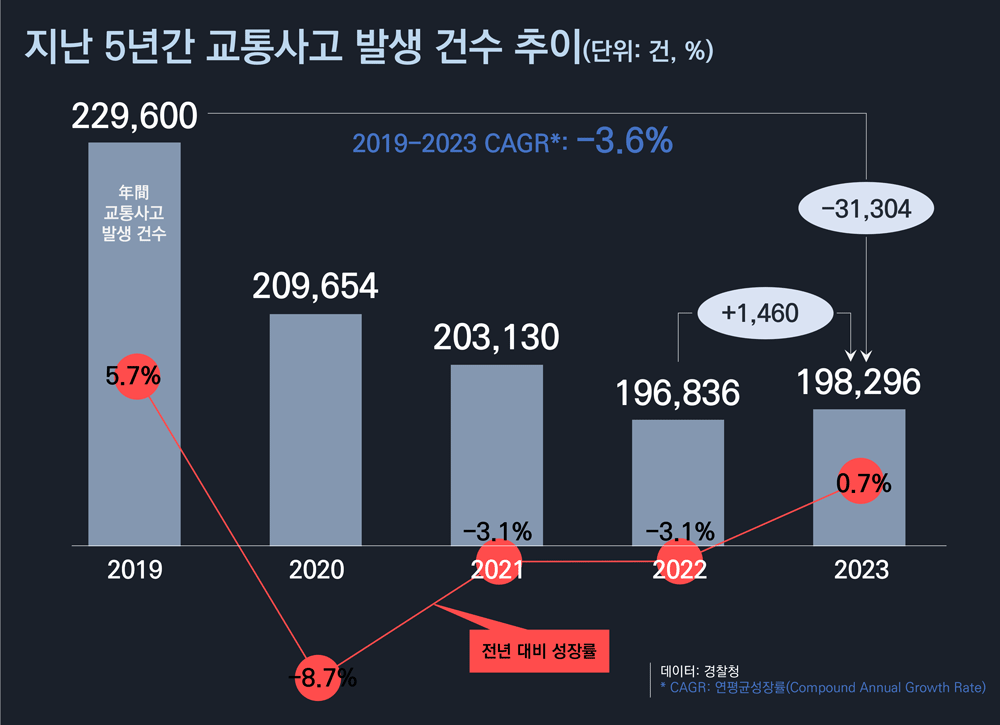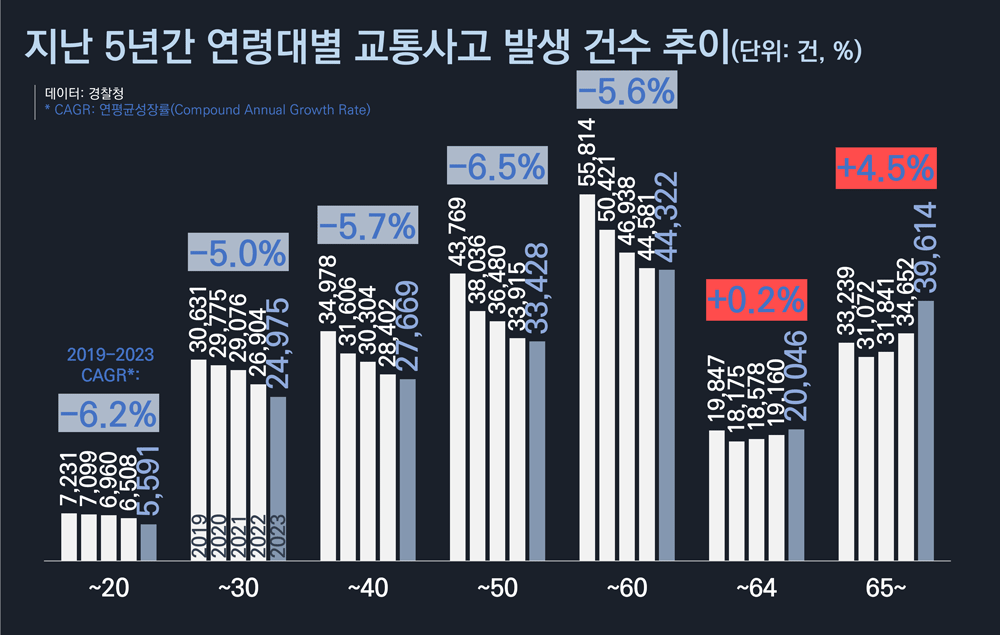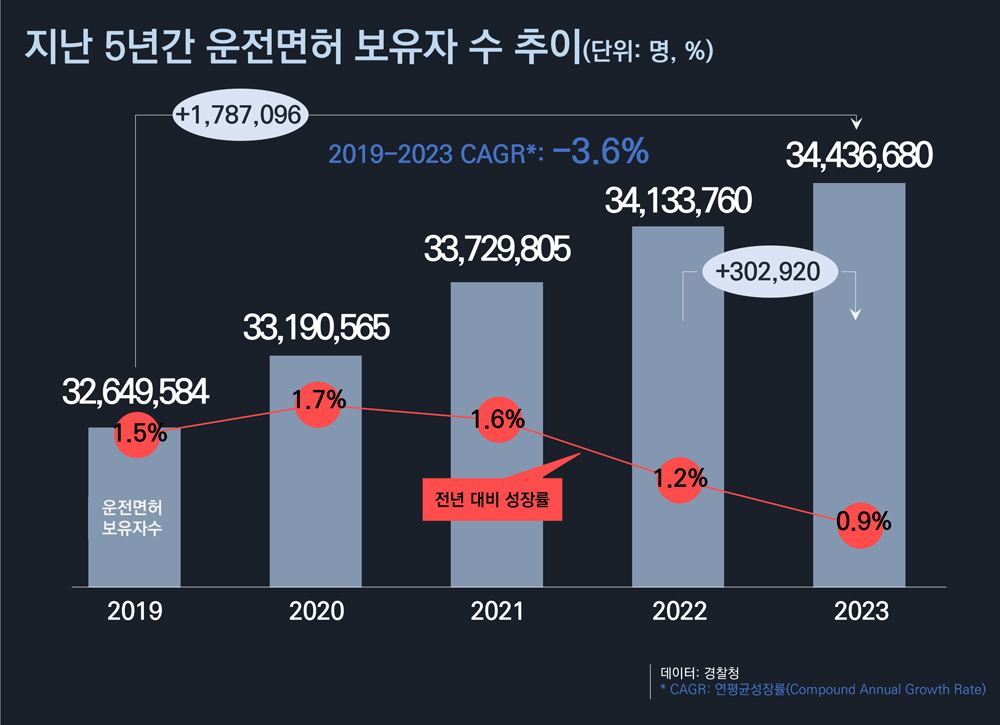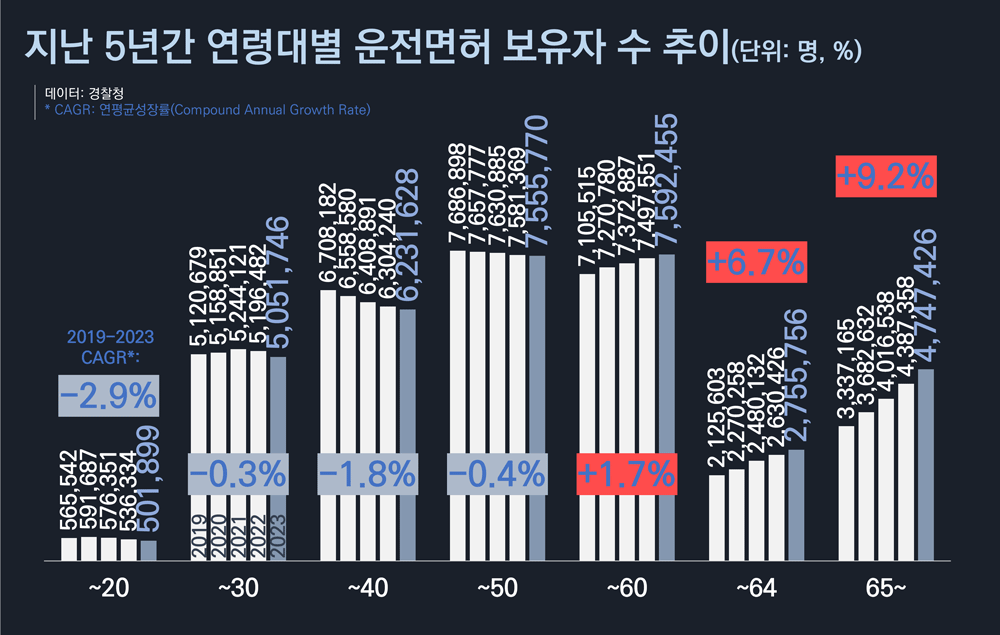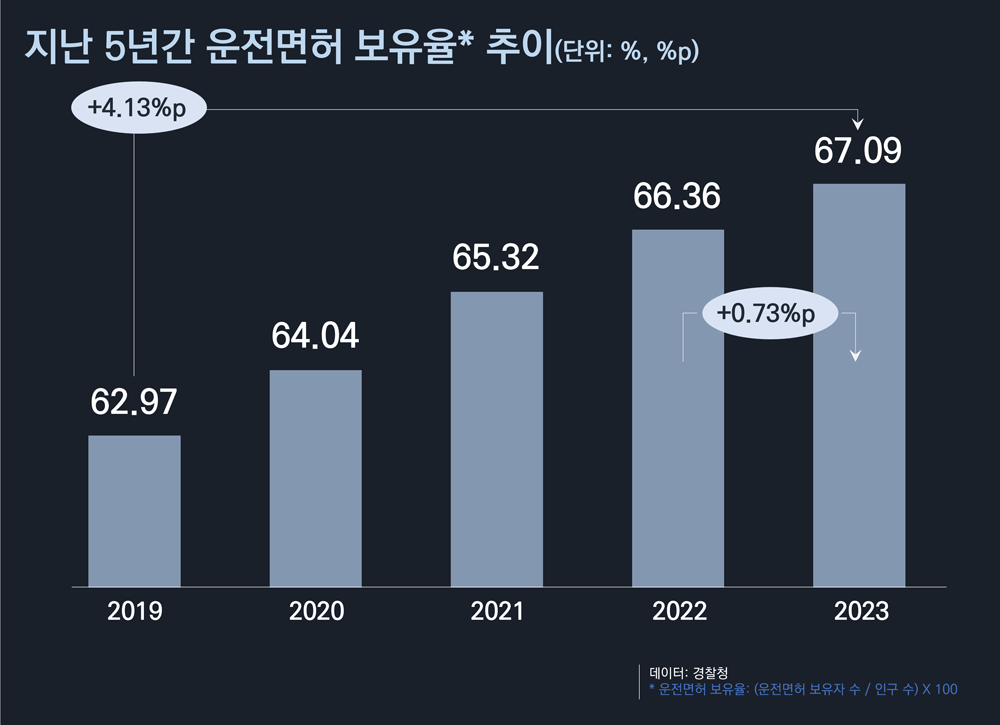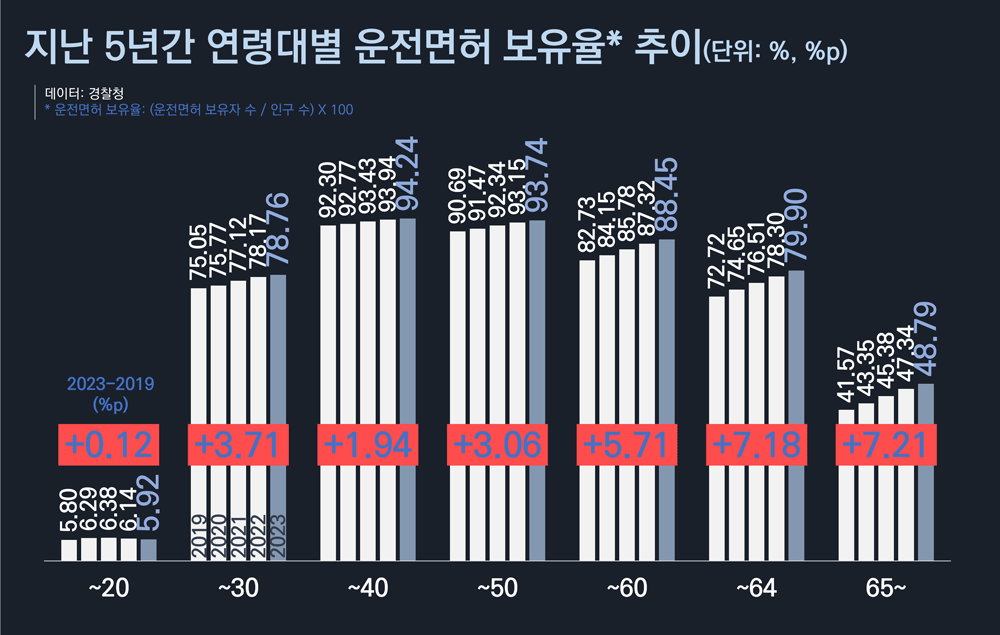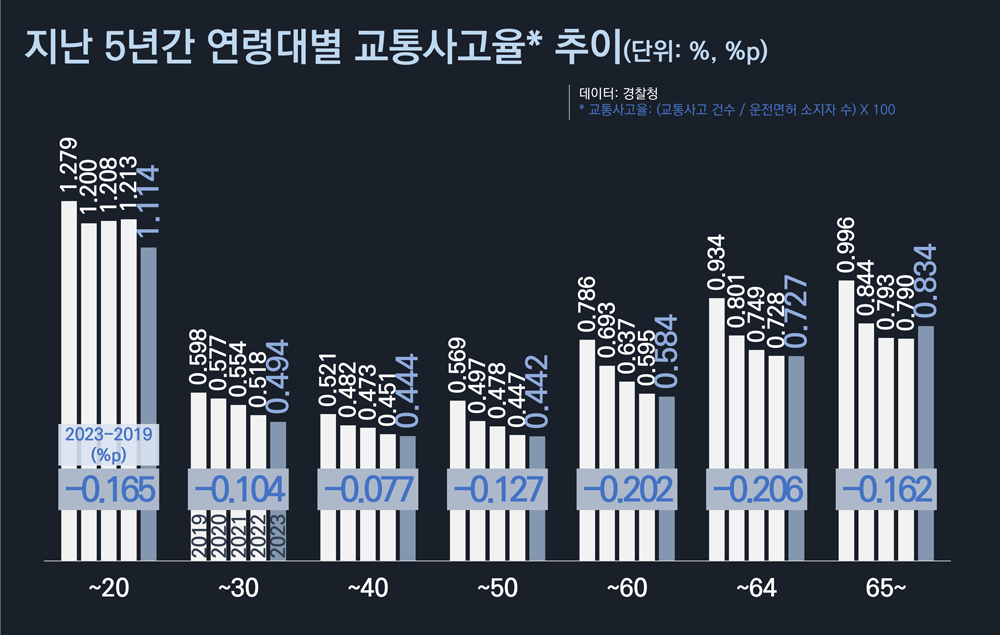(그래픽·데이터 뉴스) 최근 몇 년간 고령자(65세 이상) 교통사고가 크게 증가한 것으로 나타났습니다.
최근 언론에서 유난히 ‘고령자(65세 이상) 교통사고’에 대해 초점을 맞추고 있다는 의견이 많습니다.
다른 연령대의 교통사고도 많을 텐데, 고령자 교통사고가 유독 더 많이 발생하는 것처럼 부각시킨다는 지적입니다.
그래서 실제 통계 자료는 어떤지 빠르게 살펴봤습니다.
우선, 경찰청에서 발표한 통계 자료에 따르면, 지난 5년간 우리나라에서 발생한 교통사고 건수는 크게 보면 하락세였던 것으로 나타났습니다(그래프 1 참고).
구체적으로, 지난 2019년 전체 교통사고 건수는 22만9600건이었으나, 지난해인 2023년은 19만8296건으로 3만1304건이나 감소했습니다.
이를 연평균성장률(CAGR*)로 계산해보면 -3.6%입니다.
* Compound Annual Growth Rate, 年平均成長率
즉, 매년 3.6%씩 감소한 셈입니다.
물론, 2023년은 2022년보다 1천460건(0.7%)이 증가하긴 했지만 이는 대세에 영향을 미칠만한 수치는 아닌 것으로 분석됩니다.
그래프 1. 지난 5년간 교통사고 발생 건수 추이(단위: 건, %)
데이터: 경찰청
주: CAGR: 연평균 성장률(Compound Annual Growth Rate)
물론, 모든 연령대가 하락세였던 것은 아니었습니다.
이 통계를 연령대별로 구분해 보면, 60세 이상 구간의 교통사고 건수는 오히려 증가했기 때문입니다(그래프 2 참고).
특히, 65세 이상 구간의 교통사고 건수는 지난 5년간, 연평균성장률 기준 4.5%로 다른 연령대 대비 상당히 가파른 증가세를 보였던 것으로 나타났습니다.
그래프 2. 지난 5년간 연령대별 교통사고 발생 건수 추이(단위: 건, %)
데이터: 경찰청
주: 연평균 성장률(Compound Annual Growth Rate: CAGR)
우리나라 총인구 수는 2020년부터 감소하고 있습니다(표 1).
그러나 60세 이상 인구는 오히려 2021년부터 증가하고 있으며, 특히 65세 이상의 고령 인구는 지난 5년간 연평균성장률 4.9%의 속도로 매우 빠르게 증가하고 있습니다(그래프 3 참고).
표 1. 연도별 주민등록인구 현황(단위: 명)
| 연도 | 총인구수 | 전년 대비 증감 |
| 2010 | 50,515,666 | - |
| 2011 | 50,734,284 | 218,618 |
| 2012 | 50,948,272 | 213,988 |
| 2013 | 51,141,463 | 193,191 |
| 2014 | 51,327,916 | 186,453 |
| 2015 | 51,529,338 | 201,422 |
| 2016 | 51,696,216 | 166,878 |
| 2017 | 51,778,544 | 82,328 |
| 2018 | 51,826,059 | 47,515 |
| 2019 | 51,849,861 | 23,802 |
| 2020 | 51,829,023 | -20,838 |
| 2021 | 51,638,809 | -190,214 |
| 2022 | 51,439,038 | -199,771 |
| 2023 | 51,325,329 | -113,709 |
데이터: 행정안전부, 주민등록인구현황
그래프 3. 지난 5년간 연령대별 인구 증감 추이(단위: 명, %)
데이터: 경찰청
주: 연평균 성장률(Compound Annual Growth Rate: CAGR)
그리고 이런 추이는 ‘운전면허 보유자 수’ 통계에도 그대로 반영됐습니다.
지난 5년간 ‘운전면허 보유자 수’의 ‘전년 대비 성장률’도 매년 지속적으로 감소했기 때문입니다(그래프 4 참고).
구체적으로, 2020년 1.7%였던 ‘전년 대비 성장률’이 2023년에는 0.9%까지 하락했습니다.
그래프 4. 지난 5년간 운전면허 보유자 수 추이(단위: 명, %)
데이터: 경찰청
주: 연평균 성장률(Compound Annual Growth Rate: CAGR)
그러나 60대 이상 ‘운전면허 보유자 수’는, 지난 5년간, 해당 연령대의 인구 증가 수보다 더 가파르게 증가했습니다(그래프 5 참고).
특히, 65세 이상 구간은 연평균성장률이 9.2%나 됩니다.
참고로 50대의 경우, 인구는 0.01% 감소했지만 운전면허 보유자 수는 1.7%나 성장했습니다.
그리고 다른 연령대의 운전면허 보유자 수는 모두 감소했습니다.
그래프 5. 지난 5년간 연령대별 운전면허 보유자 수 추이(단위: 명, %)
데이터: 경찰청
주: 연평균 성장률(Compound Annual Growth Rate: CAGR)
위 통계를 기초로 지난 5년간 운전면허 보유율(전체 인구 중 운전면허 보유자 수)*을 산출해봤습니다.
* (운전면허 보유자 수 / 인구 수 ) X 100
예상대로 운전면허 보유율의 증가폭이 감소하고 있었습니다(그래프 6 참고).
60대 이상의 ‘인구’와 ‘운전면허 보유자 수’가 증가했어도 다른 연령대(특히 40대까지)는 감소했기 때문입니다.
그래프 6. 지난 5년간 운전면허 보유율* 추이(단위: %, %p)
데이터: 경찰청
주: * 운전면허 보유율: (운전면허 보유자 수 / (주민등록)인구 수) X 100
이는 운전면허 보유율을 연령대별로 살펴보면 바로 확인할 수 있습니다.
구체적으로 지난 5년간, 51세 이상 운전면허 보유율의 성장폭이 다른 연령대와는 확연히 차이가 났기때문입니다(그래프 7 참고).
그래프 7. 지난 5년간 연령대별 운전면허 보유율* 추이(단위 %, %p)
데이터: 경찰청
주: * 운전면허 보유율: (운전면허 보유자 수 / (주민등록)인구 수) X 100
이제 마지막으로 교통사고율(운전면허 소지자 대비 교통사고 건수)을 살펴보겠습니다.
지난 5년간 교통사고율은 크게 보면 하락세였습니다(그래프 8 참고).*
* 만약 이것이 코로나19의 영향이었다면 2024년부터 다시 반등할 가능성이 높을 것입니다.
그래프 8. 지난 5년간 교통사고율* 추이(단위: %, %p)
데이터: 경찰청
주: * (교통사고 건수 / 운전면허 소지자 수) X 100
그리고 이를 연령대별로 살펴보니, 지난 5년간 교통사고율은 모든 연령대에서 하락했습니다.
다만, 특이할만한 점은 유독 65세 이상 구간에서만 지난해 대비 큰 폭으로 증가했다는 것입니다.
그래프 9. 지난 5년간 연령대별 교통사고율* 추이(단위: %, %p)
데이터: 경찰청
주: * (교통사고 건수 / 운전면허 소지자 수) X 100
English version>>
Graphic Data News: Elderly Traffic Accidents Seen Through Data
In recent years, traffic accidents involving the elderly (65 years of age or older) have increased significantly.
Recently, many have commented that the media seems to be focusing on traffic accidents involving the elderly (over 65 years old).
There are also many traffic accidents involving other age groups, but it has been pointed out that traffic accidents involving the elderly are being highlighted as if they occur more often.
So, I quickly looked into the actual statistical data.
First, according to statistical data released by the National Police Agency, the number of traffic accidents in Korea over the past five years has been on a downward trend (see Graph 1).
Specifically, the total number of traffic accidents in 2019 was 229,600, but last year, in 2023, it decreased by 31,304 to 198,296.
If we calculate this as the compound annual growth rate (CAGR*), it is -3.6%.
* Compound Annual Growth Rate, 年平均成長率
In other words, it decreased by 3.6% every year.
Of course, there was an increase of 1,460 cases (0.7%) in 2023 compared to 2022, but this is not a figure that will affect the overall trend.
Graph 1. Trend of traffic accidents over the past five years (unit: cases, %)
Data: National Police Agency
Note: Compound Annual Growth Rate (CAGR)
Of course, not all age groups experienced a decline.
When we break down these statistics by age group, the number of traffic accidents in the 60+ age group actually increased (see Graph 2).
In particular, the number of traffic accidents in the 65+ age group showed a considerably steeper increase than other age groups, with an annual average growth rate of 4.5% over the past five years.
Graph 2. Trend of traffic accidents by age group over the past five years (unit: cases, %)
Data: National Police Agency
Note: Compound Annual Growth Rate (CAGR)
The total population of our country has been decreasing since 2020 (Table 1).
However, the population aged 60 or older has actually been increasing since 2021, and in particular, the elderly population aged 65 or older has been growing very rapidly at an average annual growth rate of 4.9% over the past five years (see Graph 3).
Table 1. Status of Resident Registration Population by Year (Unit: people)
Data: Ministry of Public Administration and Security, Resident Registration Population Status
Graph 3. Population increase and decrease by age group over the past 5 years (unit: people, %)
Data: National Police Agency
Note: Compound Annual Growth Rate (CAGR)
And this trend is also reflected in the statistics on the number of ‘driver’s license holders’.
This is because the ‘year-on-year growth rate’ of the ‘number of driver’s license holders’ has also continuously decreased every year for the past five years (see Graph 4).
Specifically, the ‘year-on-year growth rate’, which was 1.7% in 2020, fell to 0.9% in 2023.
Graph 4. Trends in the number of driver’s license holders over the past five years (unit: people, %)
Data: National Police Agency
Note: Compound Annual Growth Rate (CAGR)
However, the number of ‘driver’s license holders’ over 60 years old has increased more steeply than the population growth of that age group over the past five years (see Graph 5).
In particular, the average annual growth rate for those over 65 years old is 9.2%.
For reference, in the case of those in their 50s, the population decreased by 0.01%, but the number of driver’s license holders grew by 1.7%.
And the number of driver’s license holders in all other age groups decreased.
Graph 5. Trends in the number of driver’s license holders by age group over the past five years (unit: people, %)
Data: National Police Agency
Note: Compound Annual Growth Rate (CAGR)
Based on the statistics above, I calculated the driver’s license possession rate (the number of driver’s license holders among the total population)* for the past 5 years.
* (the number of driver’s license holders / the population) X 100
As expected, the increase in the driver’s license possession rate has been decreasing (see Graph 6).
This is because even though the ‘population’ and ‘the number of driver’s license holders’ over 60 years old have increased, other age groups (especially those up to 40 years old) have decreased.
Graph 6. Trend of driver’s license possession rate* for the past 5 years (Unit: %, %p)
Data: National Police Agency
Note: * Driver’s License Possession Rate: (Number of Driver’s License Holders / Population) X 100
This can be confirmed immediately by looking at the driver’s license holding rate by age group.
Specifically, over the past five years, the growth rate of the driver’s license holding rate for those aged 51 and over was clearly different from that of other age groups (see Graph 7).
Graph 7. Trends in driver’s license possession rate* by age group over the past 5 years (unit: %, %p)
Data: National Police Agency
Note: * Driver’s License Possession Rate: (Number of Driver’s License Holders / Population) X 100
Now let’s look at the traffic accident rate (number of traffic accidents per driver’s license holder).
Over the past 5 years, the traffic accident rate has been on a downward trend (see Graph 8).*
* If this was due to the impact of COVID-19, it is highly likely that it will rebound from 2024.
Graph 8. Traffic accident rate* trend over the past 5 years (Unit: %, %p)
Data: National Police Agency
Note: * (Number of traffic accidents / Number of driver’s license holders) X 100
And when we look at this by age group, the traffic accident rate has decreased in all age groups over the past 5 years.
However, what is notable is that only in the 65 and older age group, there has been a significant increase compared to last year.
Graph 9. Traffic accident rate* by age group over the past 5 years (Unit: %, %p)
Data: National Police Agency
Note: * (Number of traffic accidents / Number of driver’s license holders) X 100


